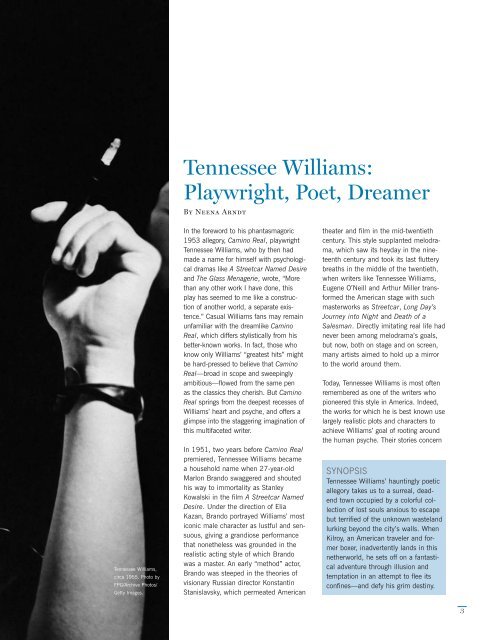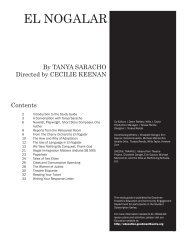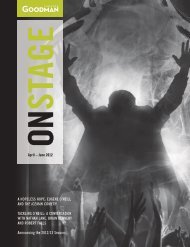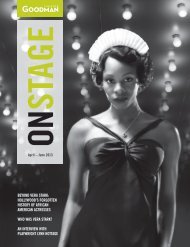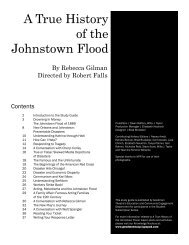Download - Goodman Theatre
Download - Goodman Theatre
Download - Goodman Theatre
You also want an ePaper? Increase the reach of your titles
YUMPU automatically turns print PDFs into web optimized ePapers that Google loves.
Tennessee Williams:<br />
Playwright, Poet, Dreamer<br />
By Neena Arndt<br />
Tennessee Williams,<br />
circa 1955. Photo by<br />
FPG/Archive Photos/<br />
Getty Images.<br />
In the foreword to his phantasmagoric<br />
1953 allegory, Camino Real, playwright<br />
Tennessee Williams, who by then had<br />
made a name for himself with psychological<br />
dramas like A Streetcar Named Desire<br />
and The Glass Menagerie, wrote, “More<br />
than any other work I have done, this<br />
play has seemed to me like a construction<br />
of another world, a separate existence.”<br />
Casual Williams fans may remain<br />
unfamiliar with the dreamlike Camino<br />
Real, which differs stylistically from his<br />
better-known works. In fact, those who<br />
know only Williams’ “greatest hits” might<br />
be hard-pressed to believe that Camino<br />
Real—broad in scope and sweepingly<br />
ambitious—flowed from the same pen<br />
as the classics they cherish. But Camino<br />
Real springs from the deepest recesses of<br />
Williams’ heart and psyche, and offers a<br />
glimpse into the staggering imagination of<br />
this multifaceted writer.<br />
In 1951, two years before Camino Real<br />
premiered, Tennessee Williams became<br />
a household name when 27-year-old<br />
Marlon Brando swaggered and shouted<br />
his way to immortality as Stanley<br />
Kowalski in the film A Streetcar Named<br />
Desire. Under the direction of Elia<br />
Kazan, Brando portrayed Williams’ most<br />
iconic male character as lustful and sensuous,<br />
giving a grandiose performance<br />
that nonetheless was grounded in the<br />
realistic acting style of which Brando<br />
was a master. An early “method” actor,<br />
Brando was steeped in the theories of<br />
visionary Russian director Konstantin<br />
Stanislavsky, which permeated American<br />
theater and film in the mid-twentieth<br />
century. This style supplanted melodrama,<br />
which saw its heyday in the nineteenth<br />
century and took its last fluttery<br />
breaths in the middle of the twentieth,<br />
when writers like Tennessee Williams,<br />
Eugene O’Neill and Arthur Miller transformed<br />
the American stage with such<br />
masterworks as Streetcar, Long Day’s<br />
Journey into Night and Death of a<br />
Salesman. Directly imitating real life had<br />
never been among melodrama’s goals,<br />
but now, both on stage and on screen,<br />
many artists aimed to hold up a mirror<br />
to the world around them.<br />
Today, Tennessee Williams is most often<br />
remembered as one of the writers who<br />
pioneered this style in America. Indeed,<br />
the works for which he is best known use<br />
largely realistic plots and characters to<br />
achieve Williams’ goal of rooting around<br />
the human psyche. Their stories concern<br />
SYNOPSIS<br />
Tennessee Williams’ hauntingly poetic<br />
allegory takes us to a surreal, deadend<br />
town occupied by a colorful collection<br />
of lost souls anxious to escape<br />
but terrified of the unknown wasteland<br />
lurking beyond the city’s walls. When<br />
Kilroy, an American traveler and former<br />
boxer, inadvertently lands in this<br />
netherworld, he sets off on a fantastical<br />
adventure through illusion and<br />
temptation in an attempt to flee its<br />
confines—and defy his grim destiny.<br />
3


